 Lake Oroville Water Operations The Department of Water Resources (DWR) continues releases from Lake Oroville to manage storage levels along with water quality and flows through the Sacramento-San Joaquin Delta. Total releases to the Feather River amount to 7,500 cubic feet per second (cfs), with adjustments being made as needed. Over the past week, inflows into Lake Oroville have been in the range of 2,600 to 2,900 cfs and are projected to remain at that level for the coming week. DWR will use the main spillway intermittently this summer for water releases to manage storage within the Oroville complex or maintain Feather River temperature levels during ongoing river valve outlet system work near the Hyatt Powerplant. When the main spillway is not in use, water may still be seen on the main spillway outlet as the seals on the eight radial gates are not designed to be watertight. The gate seals do not play a role in the structural integrity of the gates, which continue to operate as intended. DWR periodically maintains and adjusts the seals during low-reservoir conditions to improve their sealing capability. The radial gates were also last inspected and tested in Dec. 2022. Visitors to Oroville Dam may also notice minor amounts of water flowing from drains built into the emergency spillway. As the reservoir level has increased, water flow from the drains has increased, which is normal and expected with the emergency spillway design. The dam and emergency spillway continue to operate as intended. Driftwood and other floating debris on Lake Oroville are expected due to continued water inflows from tributaries and a high lake level, in combination with past wildfires impacting the watershed. Since January, DWR and California Department of Parks and Recreation (State Parks) staff have been collecting, containing, and pulling pieces of wood out of the lake and away from boat launch ramps using boom lines. However, boaters, water skiers, and other water recreationists should take precautions when operating boats on Lake Oroville and should remain alert for floating debris. The Lake Oroville reservoir is the largest storage facility in the State Water Project (SWP) and supports environmental and water delivery needs to 27 million Californians and reduces flood risks to downstream communities. DWR continues to closely monitor lake levels and will adjust releases accordingly to optimize operations for water storage and environmental protection while allowing for carryover storage into next year.  SALMON HABITAT PROJECT DWR will begin construction July 31 on a salmonid habitat improvement project in the Feather River near the Feather River Fish Hatchery and Bedrock Park in Oroville. In development since 2021, the project consists of in-river spawning gravel placement to improve existing spawning habitat sites and will also improve habitat accessibility to existing side channels by excavating and redistributing accumulated streambed material. Migratory fish species such as Chinook salmon and steelhead trout rely on Feather River spawning habitats along the low-flow channel, where most spawning activity occurs. Female salmonids lay their eggs in nests called “redds” using coarse sediment, such as clean, rounded gravel. DWR’s project will place approximately 8,000 cubic yards of gravel at multiple locations to improve spawning conditions. The project is primarily funded by two grants: the State of California Natural Resource Agency Prop 68 – Protecting California’s Rivers, Streams and Watershed Grant Program, and the Central Valley Project Improvement Act – Fish and Wildlife Restoration Activities supported by the U.S. Department of Interior. Previous DWR Feather River spawning restoration projects included the placement of 8,300 cubic yards of spawning gravel in 2014 and another 5,000 cubic yards in 2017. In-river work for the project is expected to last through the end of August. CAR-TOP BOAT LAUNCHES State Parks has reopened the Nelson Bar Car-Top Boat Launch due to receding water levels at Lake Oroville. The Nelson Bar Car-Top Boat Launch is open daily from 8 a.m. to sunset and is located along the west branch of the north fork arm of Lake Oroville; accessible via Pentz Road and Lime Saddle Road. There are three other car-top boat launches open at Lake Oroville – Vinton Gulch, Stringtown and Foreman Creek. 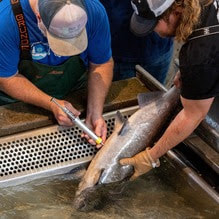 SUPPORTING SALMON HEALTH California’s Central Valley is home to four runs of Chinook salmon: spring, fall, late-fall, and winter. From climate change to loss of habitat, salmon are faced with a number of threats, and one of the latest to emerge in recent years is a thiamine deficiency. Thiamine is vitamin B1, and it is a crucial vitamin for neurons and immune systems in salmon. Evidence of a thiamine deficiency in spring-run salmon started showing up in 2019. Salmon typically get adequate levels of thiamine from their food supply in the ocean, but for the last several years that hasn’t been happening due to changes in the ocean food web. Spring-run are unique from other runs of salmon because they return to rivers in the spring and spend the summer in cold water pools before spawning early in the fall. In the Feather River, many of these fish enter the Feather River Fish Hatchery, where they are tagged for identification and released back into the river. In 2021, DWR started injecting these fish with thiamine as they passed through the hatchery in order to decrease thiamine-related mortality of their offspring. Visit our YouTube channel for a video about DWR’s collaboration to help spring-run Chinook salmon. 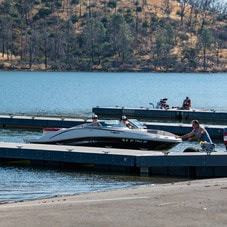 OROVILLE RECREATION The Lake Oroville Visitor Center is open Monday through Friday between 9 a.m. and 5 p.m. The Visitor Center offers numerous educational exhibits, a theater featuring videos about the building of Oroville Dam, walking and hiking trails, and a 47-foot-tall observation tower providing unsurpassed panoramic views. DWR, State Parks, and the California Department of Fish and Wildlife also maintain over 92 miles of trails in the Oroville area. An interactive map of recreation facilities, including open boat ramps, and their permitted uses (hike, bike, horse, multi) is available on DWR’s Lake Oroville Recreation webpage. A paper trail map is available at various locations, including most entrance kiosks and the Visitor Center. The marinas at Bidwell Canyon and Lime Saddle are open daily and provide a variety of services including a convenience store, gas, and boat rentals. CURRENT LAKE OPERATIONS Lake Oroville is at 885 feet elevation and storage is approximately 3.3 million acre-feet (MAF), which is 93 percent of its total capacity and 138 percent of the historical average. Feather River releases were increased to 7,500 cfs today. Flows through the City of Oroville are at 950 cfs and will decrease to 650 cfs on Saturday. Releases from the Thermalito Afterbay Outlet (Outlet) will increase to 6,850 cfs by Saturday for a total of 7,500 cfs downstream of the Outlet. DWR continues to assess releases to the Feather River daily. The public can track precipitation, snow, reservoir levels, and more at the California Data Exchange Center. The Lake Oroville gage station is identified as “ORO”. All data as of midnight 7/27/2023.  Lake Oroville Water Operations The Department of Water Resources (DWR) continues releases from Lake Oroville to manage storage levels along with water quality and flows through the Sacramento-San Joaquin Delta. Total releases to the Feather River amount to 5,000 cubic feet per second (cfs), with adjustments being made as needed. Over the past week, inflows into Lake Oroville have been in the range of 3,600 to 4,000 cfs and are projected to be lower for the coming week. DWR is currently using the main spillway for water releases to manage storage within the Oroville complex and maintain Feather River temperature levels during ongoing river valve outlet system work near the Hyatt Powerplant. When the main spillway is not in use water may still be seen on the main spillway outlet as the seals on the eight radial gates are not designed to be watertight. The gate seals do not play a role in the structural integrity of the gates, which continue to operate as intended. DWR periodically maintains and adjusts the seals during low-reservoir conditions to improve their sealing capability. The radial gates were also last inspected and tested in Dec. 2022. Visitors to Oroville Dam may also notice minor amounts of water flowing from drains built into the emergency spillway. As the reservoir level has increased, water flow from the drains has increased, which is normal and expected with the emergency spillway design. The dam and emergency spillway continue to operate as intended. Driftwood and other floating debris on Lake Oroville are expected due to continued water inflows from tributaries and a high lake level, in combination with past wildfires impacting the watershed. Since January, DWR and California Department of Parks and Recreation (State Parks) staff have been collecting, containing, and pulling pieces of wood out of the lake and away from boat launch ramps using boom lines. However, boaters, water skiers, and other water recreationists should take precautions when operating boats on Lake Oroville and should remain alert for floating debris. The Lake Oroville reservoir is the largest storage facility in the State Water Project (SWP) and supports environmental and water delivery needs to 27 million Californians and reduces flood risks to downstream communities. DWR continues to closely monitor lake levels and will adjust releases accordingly to optimize operations for water storage and environmental protection while allowing for carryover storage into next year.  A RESTORATIVE WINTER At only 29 percent capacity in December 2022, the Lake Oroville reservoir has made an astounding recovery thanks to numerous atmospheric rivers that delivered heavy amounts of rain and snow to California this winter. Lake Oroville gained more than 2.5 million acre-feet of water after Dec. 1, bringing the reservoir to its full capacity – a marked difference in just seven months. See the difference in water levels between Dec. 21, 2022, when the reservoir was at 29 percent capacity, to July 3, 2023, with Lake Oroville at 99 percent capacity. It’s a welcome sight! 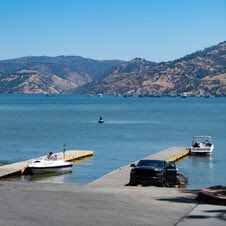 OROVILLE RECREATION A full reservoir delivers numerous opportunities for water recreation at Lake Oroville and is also a prime location to beat 100-degree weather. Water enthusiasts were out in full force at Lake Oroville during the week of July 4. Whether you enjoy swimming, boating, kayaking, jet skiing, fishing, or several other water activities, don’t miss your opportunity to relax and recreate at the lake! The marinas at Bidwell Canyon and Lime Saddle are open daily and provide a variety of services such as a shuttle and boat rentals. DWR, State Parks, and the California Department of Fish and Wildlife maintain over 92 miles of trails in the Oroville area. An interactive map of recreation facilities, including open boat ramps, and their permitted uses (hike, bike, horse, multi) is available on DWR’s Lake Oroville Recreation webpage. A paper trail map is available at various locations, including most entrance kiosks and the Visitor Center. The Lake Oroville Visitor Center is open Monday through Friday between 9 a.m. and 5 p.m. The Visitor Center offers numerous educational exhibits, a theater featuring videos about the building of Oroville Dam, walking and hiking trails, and a 47-foot-tall observation tower providing unsurpassed panoramic views. 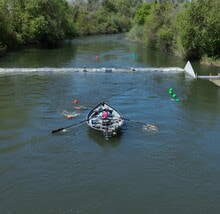 FEATHER RIVER FISH MONITORING STATION DWR is continuing construction activities for a fish monitoring station project in the Feather River in Oroville. The fish monitoring station will provide information on abundance, run timing, and origin (hatchery or natural) of steelhead and Chinook salmon populations that will be used to improve management of these fish populations in the lower Feather River. Work began in June with ongoing installation of a solar panel system along the bank of the Feather River. This week, crews also began in-water work for installation of the fish monitoring station weir that will stretch across the Feather River. Installation of the structure may be complete as early as July 21, but may extend longer due to elevated water conditions in the low-flow channel. Once installed, river users can easily pass over the floating structure using a modified passage panel. Informational signs will be posted at boat launches and near the monitoring station to assist river users in navigating over the structure. Those in more portable water vessels also have the option to use the riverbank and walk around the monitoring station. The structure is being installed along the low-flow channel of the Feather River approximately 6.5 miles downstream of the Feather River Fish Hatchery, 4.5 miles downstream of the Riverbend Boat Ramp, and 1.5 miles upstream of the Thermalito Afterbay River Outlet Boat Ramp.  CAMPING AT LAKE OROVILLE The summer months invite everyone to get outside and enjoy the benefits of longer daylight hours. However, summer heat can make recreating outdoors tiring, which makes Lake Oroville the perfect place for your next camping adventure. The Lake Oroville State Recreation Area boasts 167 miles of shoreline and numerous tent, trailer or boat camping sites operated by State Parks. With the lake a short distance away, campers can cool off in the refreshing water one minute and grill some burgers on a barbecue the next. Lake Oroville is also home to floating campsites and boat-in campgrounds for those looking to spend more time on the water. Reserve a camping site at https://reservecalifornia.com or contact State Parks at (800) 444-7275.  WALK INTO WELLNESS Join State Parks for a guided, meditative walk around the Lake Oroville State Recreation Area that promotes health and wellness. Free walks focus on calming reflections and enlightening exercises while immersed in the beauty of nature. Sturdy shoes and a water bottle are recommended for participants. The last wellness walk is scheduled from 8 a.m. to 10 a.m. on Sunday, July 16 at Bidwell Canyon; meet at the Toll House Museum. CURRENT LAKE OPERATIONS Lake Oroville is at 894 feet elevation and storage is approximately 3.45 million acre-feet (MAF), which is 98 percent of its total capacity and 136 percent of the historical average. Feather River releases are at 5,000 cfs today to meet downstream Delta water quality and outflow. Flows through the City of Oroville were increased to 1,500 cfs and releases from the Thermalito Afterbay Outlet (Outlet) are at 3,500 cfs for a total of 5,000 cfs downstream of the Outlet. With increasing temperatures additional flow fluctuations may occur next week through the City of Oroville. DWR continues to assess releases to the Feather River daily. The public can track precipitation, snow, reservoir levels, and more at the California Data Exchange Center. The Lake Oroville gage station is identified as “ORO”. All data as of midnight 7/13/2023.  Lake Oroville Water Operations Winter storms and spring snowmelt filled the Lake Oroville reservoir to capacity, an increase of more than 2.5 million acre-feet of water since Dec. 1. The Department of Water Resources (DWR) continues releases from Lake Oroville through the Hyatt Powerplant and Thermalito Afterbay River Outlet. Total releases to the Feather River amount to 3,000 cubic feet per second (cfs), with adjustments being made to manage storage levels along with water quality and flows through the Sacramento-San Joaquin Delta. Over the past week, inflows into Lake Oroville have been in the range of 2,800 to 3,700 cfs and are projected to be in the same range for the coming week. DWR may intermittently use the main spillway this summer for water releases to manage storage within the Oroville complex or maintain Feather River temperature levels during ongoing river valve outlet system work near the Hyatt Powerplant. When the main spillway is not in use water may still be seen on the main spillway outlet as the seals on the eight radial gates are not designed to be watertight. The gate seals do not play a role in the structural integrity of the gates, which continue to operate as intended. DWR periodically maintains and adjusts the seals during low-reservoir conditions to improve their sealing capability. The radial gates were also last inspected and tested in Dec. 2022. Visitors to Oroville Dam may also notice minor amounts of water flowing from drains built into the emergency spillway. As the reservoir level has increased, water flow from the drains has increased, which is normal and expected with the emergency spillway design. The dam and emergency spillway continue to operate as intended. Driftwood and other floating debris on Lake Oroville are expected due to continued water inflows from tributaries and a high lake level, in combination with past wildfires impacting the watershed. Since January, DWR and California Department of Parks and Recreation (State Parks) staff have been collecting, containing, and pulling pieces of wood out of the lake and away from boat launch ramps using boom lines. However, boaters, water skiers, and other water recreationists should take precautions when operating boats on Lake Oroville and should remain alert for floating debris. The Lake Oroville reservoir is the largest storage facility in the State Water Project (SWP) and supports environmental and water delivery needs to 27 million Californians and reduces flood risks to downstream communities. DWR continues to closely monitor lake levels and will adjust releases accordingly to optimize operations for water storage and environmental protection while allowing for carryover storage into next year.  CAMPING AT LAKE OROVILLE The summer months invite everyone to get outside and enjoy the benefits of longer daylight hours. However, summer heat can make recreating outdoors tiring, which makes Lake Oroville the perfect place for your next camping adventure. The Lake Oroville State Recreation Area boasts 167 miles of shoreline and numerous tent, trailer or boat camping sites operated by State Parks. With the lake a short distance away, campers can cool off in the refreshing water one minute and grill some burgers on a barbecue the next. Lake Oroville is also home to floating campsites and boat-in campgrounds for those looking to spend more time on the water. Reserve a camping site at https://reservecalifornia.com or contact State Parks at (800) 444-7275. OROVILLE DAM CITIZENS ADVISORY COMMISSION The California Natural Resources Agency hosted a virtual Oroville Dam Citizens Advisory Commission meeting today via Zoom. In addition to public comment, presentations on dam safety projects and fiscal year 2023–24 Oroville Dam facility expenditures were provided. The Commission also continued conversations about inundation maps. The Citizens Advisory Commission is a forum for questions and feedback from the communities surrounding Oroville Dam. For information on the meeting, please visit https://bit.ly/OrovilleCAC. A transcript of the meeting will be available on the webpage in the coming weeks.  WALK INTO WELLNESS Join State Parks for a guided, meditative walk around the Lake Oroville State Recreation Area that promotes health and wellness. Free walks focus on calming reflections and enlightening exercises while immersed in the beauty of nature. Sturdy shoes and a water bottle are recommended for participants. The last wellness walk is scheduled from 8 a.m. to 10 a.m. on Sunday, July 16 at Bidwell Canyon; meet at the Toll House Museum.  OROVILLE RECREATION The Lake Oroville Visitor Center is open Monday through Friday between 9 a.m. and 5 p.m. The Visitor Center offers numerous educational exhibits, a theater featuring videos about the building of Oroville Dam, walking and hiking trails, and a 47-foot-tall observation tower providing unsurpassed panoramic views. DWR, State Parks, and the California Department of Fish and Wildlife maintain over 92 miles of trails in the Oroville area. An interactive map of recreation facilities, including open boat ramps, and their permitted uses (hike, bike, horse, multi) is available on DWR’s Lake Oroville Recreation webpage. A paper trail map is available at various locations, including most entrance kiosks and the Visitor Center. The marinas at Bidwell Canyon and Lime Saddle are open daily and provide a variety of services such as a shuttle and boat rentals. CURRENT LAKE OPERATIONS Lake Oroville is at 897 feet elevation and storage is approximately 3.49 million acre-feet (MAF), which is 99 percent of its total capacity and 133 percent of the historical average. Feather River releases were increased to 3,000 cfs today to meet downstream Delta water quality and outflow. Flows through the City of Oroville will be decreasing over the weekend. By Sunday, flows through the City of Oroville will be at 650 cfs and releases from the Thermalito Afterbay Outlet (Outlet) will be at 2,350 cfs for a total of 3,000 cfs downstream of the Outlet. With increasing temperatures additional flow fluctuations may occur next week through the City of Oroville. DWR continues to assess releases to the Feather River daily. The public can track precipitation, snow, reservoir levels, and more at the California Data Exchange Center. The Lake Oroville gage station is identified as “ORO”. All data as of midnight 7/6/2023. |
Archives
May 2024
Categories
All
|

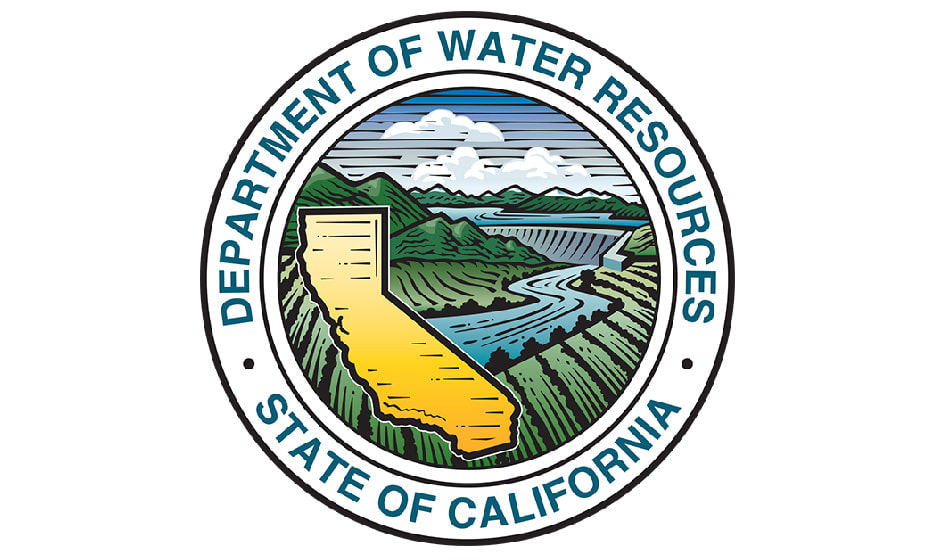
 RSS Feed
RSS Feed